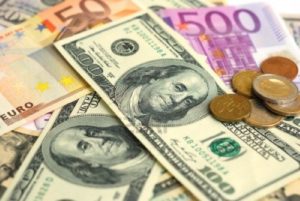 The euro edged lower on Friday, but marked a fifth consecutive week of advances against the US dollar, after a mixed string of data coming from the US and the Euro zone. Investors weighed the chances of a Fed tapering in the upcoming week.
The euro edged lower on Friday, but marked a fifth consecutive week of advances against the US dollar, after a mixed string of data coming from the US and the Euro zone. Investors weighed the chances of a Fed tapering in the upcoming week.
Having hit a session high at 1.3769 at 08:30 GMT on Friday, EUR/USD closed at 1.3742 on Friday, losing 0.09% on a daily basis. However, the EUR/USD pair marked a fifth consecutive week of gains. On Wednesday EUR/USD touched six week highs at 1.3811. Support was likely to be received at December 9th low, 1.3695, while resistance was to be encountered at December 12th high 2010 high, 1.3803.
On Friday, the U.S Bureau of Labor Statistics released a report that showed the producer price inflation in November fell by seasonally adjusted 0.1% in line with expectations. Prices of finished goods declined 0.2% in October and 0.1% in September. On an unadjusted basis, the PPI rose 0.7% in November during the 12 months through November, short of analysts’ projections of a 0.8% increase. In October the PPI increased 0.3% compared to the same month a year ago. The Producer Price Index (PPI) measures the change in the price of goods sold by manufacturers. It can be seen as a leading indicator of consumer price inflation, which represents the majority of overall inflation.
A separate report showed that Core PPI rose by 0.1% in November in line with analysts’ expectations. In October the index increased by 0.2%. On a year-on-year basis, Core PPI increased 1.3%, short of analysts’ projections of a 1.4% increase and compared to another 1.4% gain in October. The Core Producer Price Index measures the change in the selling price of goods and services sold by producers, excluding food and energy.
On Thursday, the Commerce Department reported that retail sales rose solidly in November as Americans purchased automobiles and a range of other goods. Retail sales rose by 0.7% last month, beating analysts’ projections for a 0.6% gain, while October’s reading received an upward revision to 0.6% from initially estimated at 0.4%. The upbeat general indicator was lifted by a 1.8% jump in sales at auto and parts dealers, which offset a 1.1% decline in fuel prices.
Retail sales less autos, which exclude the volatile automobile sales, rose by 0.4% from an upwardly revised 0.5% a month earlier, exceeding expectations of a 0.2% advance.
Core retail sales, which exclude automobiles, food services, gasoline and building materials and correspond more closely to the consumer spending component of GDP jumped by 0.5% after advancing 0.7% in October.
The overall upbeat US data added to the steadily building-up positive sentiment for the US economic recovery, increasing bets for a Fed tapering.
Demand for the greenback was supported by speculations that an agreement on a two-year US budget deal could prompt the Fed to taper its stimulus program, which tends to devalue the US dollar. Central bankers are set to reconvene next week. According to 34% of economists, participated in a Bloomberg survey on December 6th, the FOMC may begin to scale back its 85-billion-USD monthly asset purchases at the committee’s policy meeting on December 17th-18th rather than wait until January or March.
Meanwhile, on Thursday, data by Eurostat, showed that the industrial output in the 17-nations common area declined 1.1% in October from a month earlier. Median analysts’ estimate predicted the industrial production will rise 0.3% this month. In September, the industrial output was revised to a 0.2% decline, compared to initially estimated drop of 0.5%. On annual basis, output in the industry sector added a mere 0.2% in October, short of analysts’ expectations of a 1.1% gain and after it gained 0.2% in the previous month. The report showed that overall decline in industrial production was mainly driven by a 2.4% decrease in production of durable consumer goods and a 4% drop in energy production.
“While there is an economic recovery in the euro area, the momentum is slowing, but for the euro to take a sustained hit to the downside we definitely need the ECB to really move to a more dovish message,” said Alvin Tan, a London-based director of foreign-exchange strategy at Societe Generale SA, cited by Bloomberg.
The ECB decided at its meeting on December 5th to keep the main refinancing rate unchanged at 0.25 percent, while ECB President Mario Draghi had said that borrowing costs will stay low for an extended period of time.
EUR/USD cross may be influenced by a number of reports, scheduled for publication during the week, as follows:
On Monday (December 16th), Germany, which is the largest economy in the Euro zone, will publish reports on Preliminary Manufacturing PMI and Preliminary Services PMI for December, while the Euro zone will publish data on the same indicators and for the same period later in the day. Meanwhile, US will release data on Non-farm Productivity and Unit Labor Costs for the third quarter, Preliminary Manufacturing PMI for December, Treasury International Capital Flows for October and Industrial Production for November. Market players also await the statement of the ECB President Mario Draghi.
On Tuesday, (December 17th), Germany will report data on the ZEW economic sentiment for December and ZEW current situation, which are both based on surveys. The Euro zone will publish the same indicators plus a Harmonized Index of Consumer Prices for November and a final Harmonized Index of Consumer Prices for the whole year through November. Meanwhile, US will report its Consumer Price Index for November and the same index for the 12 months until November. A separate report will show the Core Consumer Price Index for November and for the whole year through November. Another important indicator will be reported, the current account for the third quarter.
On Wednesday, (December 18th), the keenly-anticipated FOMC policy meeting will be held. At the meeting the officials will take decisions, concerning the interest rate and the amount of Fed stimulus, which now consists of $85 billion in monthly bond purchases, but may be trimmed by the policy makers.
On Thursday, (December 19th), the Euro zone will report its current account for October. Later, the US will publish the Philadelphia FED index for December and the Existing Home Sales for November.
On Friday, (December 20th), US will report its final GDP for the third quarter, as well as Personal Consumption Expenditures and Core Personal Consumption Expenditures for the same quarter. Meanwhile, the Euro zone will publish its Economic Sentiment Indicator for December, which is based on a survey among managers five key economic sectors.
The euro was the best performer among 10 developed-nation currencies, tracked by Bloomberg Correlation-Weighted Indexes, gaining 9.5% in the past year, while the greenback had appreciated 4%.





